Life has never been easy for Espanyol fans. Just like Rayo Vallecano, Leganes or Getafe have always been living in the shadows of Real Madrid at the capital, Espanyol was always known as the smaller club in Barcelona. Even now, when Girona finally made it to the top flight, things have not started to look up.
We don’t have to look far back in order to find proof of that thesis. The Barcelona outfit scored just 36 goals in 38 games last season, and then the (mostly) freshly appointed Quique Sanchez Flores was sacked in April as the club was dancing the relegation dance with only five games to go until the end of the season.
They had a bad summer before that, and a bad one preceding this season as most of the key personnel was either sold for peanuts or loaned out in bad deals that hurt the club. The likes of Gerard Moreno or even some new faces like Marc Navarro were shipped away, and the profit was simply non-existent, and therefore not used to strengthen the squad.
But still, the dark cloud of pessimism that spread all over the south-western part of Barcelona has recently let some rays of optimism through. The appointment of Joan Francesc Ferrer Sicilia, or simply known as Rubi, has brought many changes for the royal club of Espanyol.
But after an initial resurgence, the Catalans are back to fighting an uphill battle.
This tactical analysis will use statistics and insight to determine whether Espanyol should once again be worried or do they have the firepower under Rubi to weather the storm that has been brewing for quite some time now.
The Catalan renaissance
Rubi really did start from scratch when he took over a significantly weaker side to the one that was in the hands of Flores before him. Surprisingly enough, the preseason went marvelously and Espanyol ended up being the Spanish side with the best record abroad, winning all six of their games in the process.
But that was only preseason and while it may have some connotations when it comes to form, state of the team or even predicting how the upcoming campaign might go, it is usually, for the most part, taken for granted and as a meaningless exhibition.
To everyone’s surprise, Rubi continued his unbeaten streak in La Liga as well. Their opening fixture was a tough away visit to Celta Vigo. The team ended up getting a point for their troubles, and while that result was good, no one thought much of it.
Until the next week, that is.
Espanyol vs Valencia: The beginning of something good
If you ask top-flight Spanish teams about Valencia, almost all of them will confirm that they pack one hell of a punch. The Bats of Valencia usually fly in the upper levels of the La Liga table, and while this season might be an oddity for them, as well as for others, Espanyol did not have their hopes up in the second round.
Honestly, a rough and well-fought victory was expected for the visitors inside of the Estadi Cornellà-El Prat but instead, they went back home with no spoils to their name, and a net filled with two goals in it.
Quite a remarkable result but the manner in which it was done was what made it even more impressive. Rubi somehow took a fairly weakened side, aided only by homegrown talent, and players that had to make a step-up to the senior team, and dominated the match.
The first thing that was noticeable was the way the team attacked: Aggressive, proactive, with fast transitions and excellent counter-attacking mechanisms that were used to the best of their potential.
Rubi also brought much more balance to the team. Espanyol still look to preferably attack through their right wing and to combine that with lethal interiors but looking at the way they score goals this season, both the right and the left are utilized almost equally with 34% on the left, and 39% on the right, and with more emphasis on the middle (27%) than ever before.
Although it might seem like the difference is still there, when we compare it to last season’s 35% – 27% – 42%, the change is palpable.

The image above is the prototype of Espanyol’s counter-attacking mechanism that they practice this season. After a quick set piece clearance, both wings spread the pitch as much as possible, and transitions are made quickly and more importantly, successfully.
Although this specific example did not result in a goal for the hosts, last season they had zero goals scored through counter-attacks while in the 2018/2019 campaign they already have two to their name, which totals to 12% of all their goals.
Just in this one game, they made four fast-break chances, like the one pictured above, and that was a sign of playing to their strengths.
Another change that was implemented is the set piece emphasis. This season alone they have four goals from that specific tactic while last season they finished with six in total.
Numerous chances arrived directly from a cross into the box, whether it was from a corner kick, free kick or simply from open play. As a result, in that game alone, Espanyol managed 20 crosses and 63% of all of their shots came within the 18-yard area.
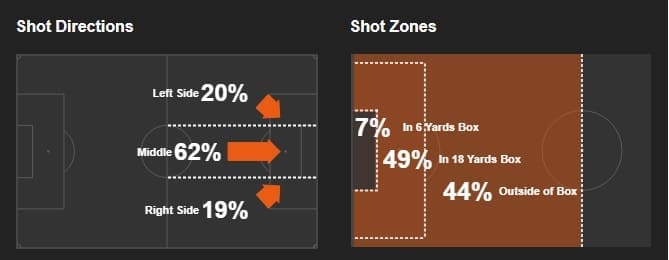
In many ways, that game against Valencia was the beginning of something good, and what followed was more of the same, and Rubi getting the most out of this new-found formula.
Hot and cold
The winds were definitely changing, and after taking down one of the biggest fish in La Liga, Espanyol was high on confidence, and the optimism was palpable. Still, they needed a couple of games to get used to the new rhythm of things.
Unfortunately, they could not follow up that great win at home with a string of similar results. A defeat to Alaves and Real Madrid in the following weeks were worrying but also a much-needed medicine to bring them back to reality.
Goals that they conceded against those two teams meant that they would have to patch-up in defense quickly if they wanted to regain their prominence.
Rubi had two solutions in mind: high-press or a low defensive block, depending on the situation. Both worked wonders as Espanyol established one of the best defenses from open play in the league, equal to the one of Real Madrid.
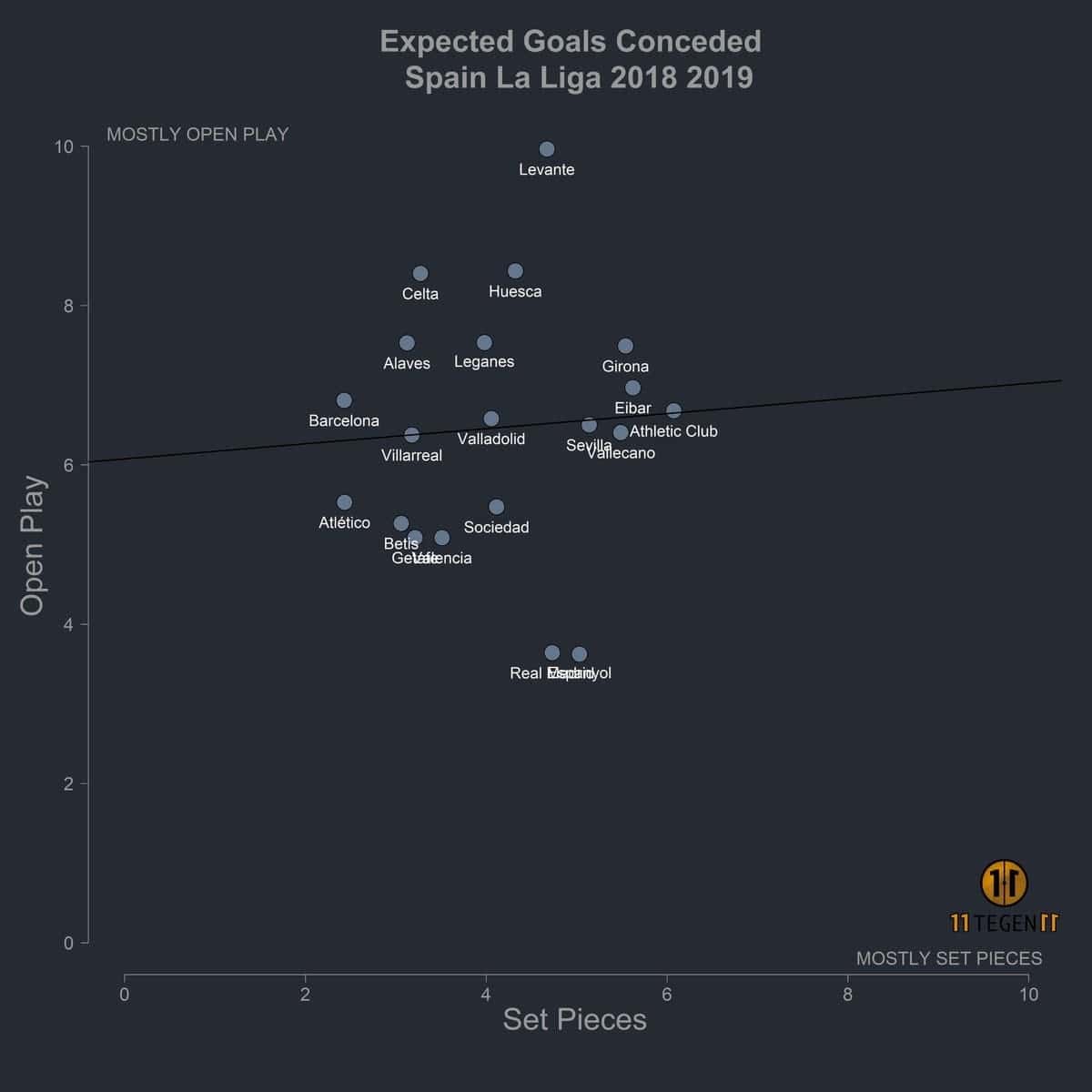
The way Rubi defended those open play situations is mostly with a high press. Notice below how the team never allows the flow of attack to proceed. Usually, this would either end up in a forced clearance, and an aerial duel (which they preferred), or a quite dangerous attempt to play from the back.
As a result, they have created 79.85 recoveries this season, mostly due to a good choice of setup and tactics.

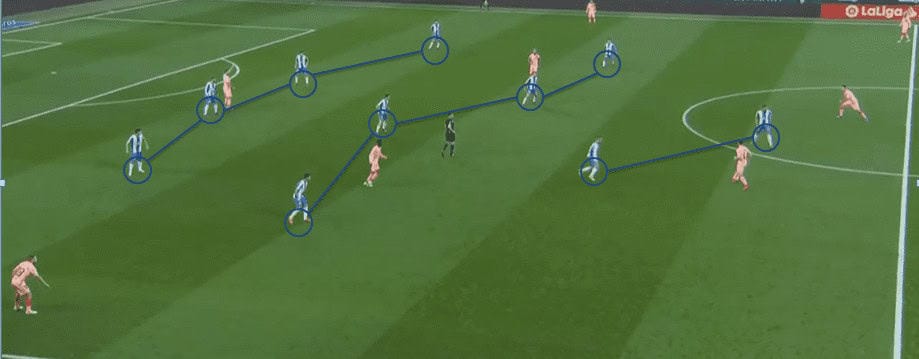
Who flies high, falls deep
The Catalan side enjoyed their best run dating years back, racking up a streak of six games unbeaten in the process. For a while, they went toe to toe with the best teams of La Liga, clinging to first and second place respectively with their city rivals, Barcelona.
But the dream did not last for too long, though, as Espanyol is now on a bad streak once again. Rubi’s side couldn’t sustain their form and as a result, they were defeated in the last four games, including a bitter poker of goals conceded to Barcelona in Saturday’s clash at the RCDE Stadium.
This drops them back to a ninth place with a pretty bad record to show for. They now have the 11th best defensive record in the league, as well as 20 goals conceded with the xG of 19.3. This shows that they leak more goals then it’s expected from the opportunities they yield to opponents.
Ironically, most of those goals (13) were conceded through open play, which was initially what they were the best at stopping, and seven through set pieces. This stat also puts them in the lower brackets of La Liga in that aspect of the game.
The game against Barcelona showed some old cracks reappearing once more.
Rubi decided to deploy his 4-3-3 formation, which is used 27% of the time, as opposed to the more dominant 4-4-2 (37%) but that was more to compensate for some absences in the team but also to counter Barcelona’s strengths.
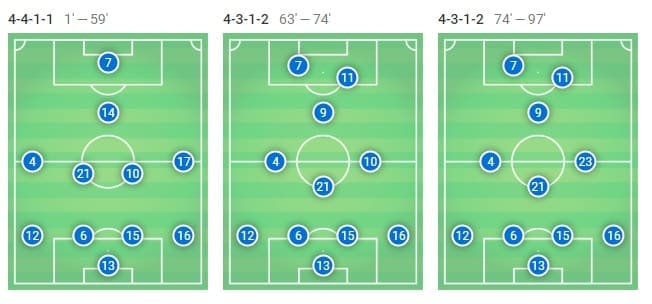
He knew that their rivals tend to leave free space behind their flanks, especially after Alba and Semedo overlap, leaving their backs exposed to quick counters, something Espanyol excel at. Still, this was negated by Vidal and Rakitić respectively, and getting to good shooting positions was a nigh impossible task.
The key was, once again, getting on that counter as quickly as possible. Throughout the early stages of the season, Espanyol thrived at stealing the ball away from their opposition, preferably in their own half, and then striking at them in a fast transition.
This time, their high press was not as effective, and when it was bypassed, they were left vulnerable to the Messi – Suarez – Dembele trio. You could say they probably missed the influence of their best player in defense (and the team overall), Mario Hermoso, but the problem was much bigger than that.
The best chances were still created on the counter but the finishing touches, especially in 1v1 situations, were missing. This also comes as a surprise because you could list that trait as one of their strengths at the beginning of the season.
What was also visible was the difficulty Espanyol faced in the build-up. Their midfield was unusually deeper than before, and they had troubles successfully creating anything that was not either a counter or a set-piece.
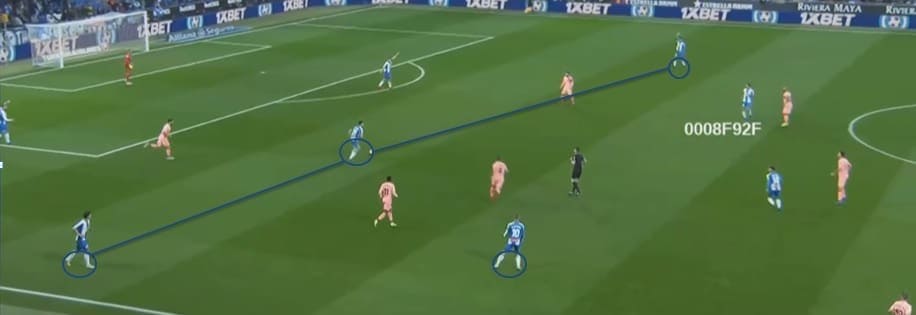
Notice how they start building from the back, which is not necessarily completely out of the blue for this Espanyol side but they were missing the key pieces of that puzzle in Hermoso in order to be successful at it, especially against a high press team like Barcelona.
Conclusion
The main question that needs to be answered here is weather Espanyol should be worried about their immediate future. To quickly answer that – yes.
The reason for that is the tough schedule and the falling off in form, which was most probably caused by the lack of any real bench depth. Two summer windows were wasted and the club was only weakened by it.
While the squad had a full tank to use, those exhausting but rewarding tactics that Rubi implemented seemed to work wonders. But, as we get further down the line, they either get exploited because of them or they just can’t sustain it for long enough because of tired legs, among other things.
Two seasons ago, the club got a new owner in Chen Yansheng, who promised that there can be “two powerful clubs in Barcelona”, and for a while, it really did seem like that was truly possible.
Rubi obviously has it in him to revolutionize this Espanyol squad but does he have the personnel and the support to reach his dreams and eventually, catch them?
That’s a question for another time.
If you love tactical analysis, then you’ll love the digital magazines from totalfootballanalysis.com – a guaranteed 100+ pages of pure tactical analysis covering topics from the Premier League, Serie A, La Liga, Bundesliga and many, many more. Get your copy of November’s issue for just £4.99 here or preorder the first of TWO December issues right here.

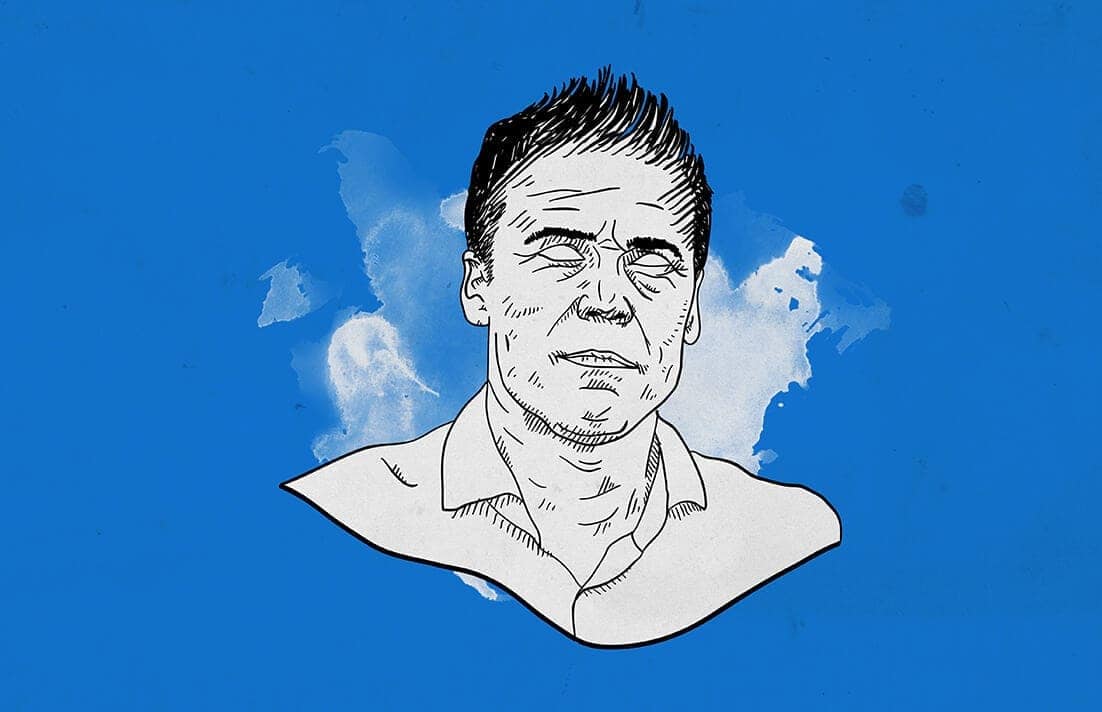




Comments